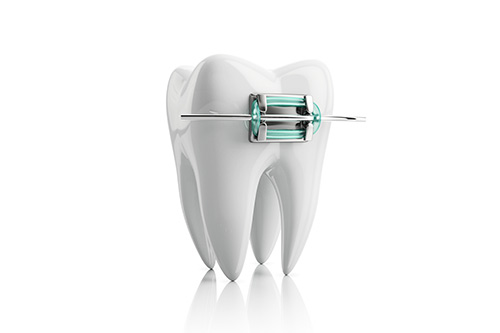How orthodontic treatment works
At the end of “active” treatment (when teeth are being moved), most patients will wear retainers to give the new bone a chance to harden and support the new positions of the teeth.
It’s truly a complex biological process, and orthodontists master the multi-faceted intricacies of orthodontic treatment through years of study, including four years of dental school followed by two-to-three years of education in an accredited orthodontic residency program.

Appliances Used in Orthodontic Treatment
Orthodontists use a variety of “appliances” to move teeth and align jaws. Braces may be top-of-mind when you think about orthodontic treatment. But there are many more appliances that orthodontists use in treatment.
What kinds of appliances are there?
Here are examples of some of the orthodontic appliances used to move teeth and align jaws:
Braces
Braces are the most common appliance used is orthodontic treatment. Fortunately, they have come a long way. Basically, braces have two parts: brackets and wires. Wires move the teeth; brackets serve as stationary handles to hold the wires. As needed for an individual’s treatment, other components can be added.
Contemporary braces can be:
- Stainless steel
- Gold-colored
- Tooth-colored ceramic
Brackets are affixed directly to teeth. Wires are threaded through slots in the brackets. Most braces go on the front of the teeth. Sometimes braces can be put on the backs of teeth – these are called “lingual” braces. These are virtually invisible. Not all orthodontists offer this form of treatment, and not all kinds of orthodontic problems can be successfully treated with lingual braces. The wires on some braces are held in place by tiny rubber bands (“ligatures”), and come in a huge assortment of colors. Other braces are “self-ligating” – they do not require ligatures to hold the wires in place.
Clear aligners
People sometimes call clear aligners “invisible braces.” They are made of a transparent plastic-like material. They are made to fit the patient’s teeth at different stages of their treatment. Each set of aligners is worn for 1-3 weeks, at least 22 hours a day, before moving on to the next set. Each set is engineered to move the teeth incrementally, per the orthodontist’s treatment plan, until the desired alignment is reached. Tooth-colored attachments on the teeth will help aligners move teeth properly. Some, but not all, kinds of orthodontic problems can be successfully treated with clear aligners.
Temporary Anchorage Devices (TADs)
Temporary anchorage devices, or TADs, are tiny implants used as a fixed point from which to apply force to move teeth predictably. They can be placed in many different sites in the mouth, depending upon the patient’s needs. TADs are removed when no longer needed.
Power chains
Power chains are sometimes used with braces. A power chain is stronger than individual elastic o-rings, so they can apply extra force when needed.
Which treatment is fastest?
Thanks to advances in technology, just about every type of treatment is relatively fast. AAO orthodontists make use of the full range of orthodontic appliances – not just one or two – and will recommend the type they believe is best suited to correcting your individual orthodontic problem in the most efficient manner possible.
To make treatment go as quickly as possible:
- Follow your orthodontist’s instructions on brushing and flossing.
- See your dentist for a professional cleaning at least every six months during orthodontic treatment, or more often if recommended.
- Watch what you eat if you have braces – avoid hard, sticky, and crunchy foods. Opt for foods that are soft and easy to chew.
- Beware of sugary, acidic soft drinks including regular and diet soda pop, fruit juices, fruit drinks and sports drinks. Tap water is recommended.
- Wear your elastics (rubber bands) as instructed.
- Keep scheduled appointments with your orthodontist.
Which treatment is best?
The best treatment is the kind performed by an AAO orthodontist, who has a minimum of 3,700 hours (2 or more years) in an orthodontic residency after 4 years of dental school. Orthodontic treatment is a customized professional service performed and monitored by a highly-educated healthcare professional. Orthodontic treatment is not a product. Moving teeth and aligning jaws requires a comprehensive knowledge of the biological and physiological processes at play to safely and predictably move teeth into new, healthy positions. The type of treatment (such as braces or aligners) or brand of appliance is less important than the knowledge and skill of the individual who performs your treatment.
Removing Teeth
On occasion, it may be necessary to remove teeth to achieve a healthy bite.
